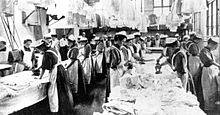
Back ملجأ مجدلي Arabic Labahan ni Magdalena BCL Asil de les Magdalenes Catalan Magdaleniny prádelny Czech Magdalenenheim German Asilo de las Magdalenas Spanish Magdalenen babes-etxeak Basque Couvent de la Madeleine French Magdalena-asyl Frisian Tithe Níocháin Maigdiléanacha Irish

Magdalene asylums, also known as Magdalene laundries, were initially Protestant but later mostly Roman Catholic institutions that operated from the 18th to the late 20th centuries, ostensibly to house "fallen women". The term referred to female sexual promiscuity or sex workers, young women who became pregnant outside of marriage, or young girls and teenagers who did not have familial support.[2] They were required to work without pay apart from meagre food provisions, while the institutions operated large commercial laundries, serving customers outside their bases.
Many of these "laundries" were effectively operated as penitentiary workhouses. The strict regimes in the institutions were often more severe than those found in prisons. This contradicted the perceived outlook that they were meant to help women as opposed to punishing them. A survivor said of the working conditions: "The heat was unbelievable. You couldn't leave your station unless a bell went."[3] Laundries such as this operated in the United Kingdom, Ireland, Sweden, Canada, the United States, and Australia, for much of the 19th and well into the 20th century, the last one closing in 1996.[4] The institutions were named after the Biblical figure Mary Magdalene.
The first Magdalene institution was founded in late 1758 in Whitechapel, England.[5] A similar institution was established in Ireland by 1767.[5] The first Magdalene asylum in the United States was the Magdalen Society of Philadelphia, founded in 1800. All these were Protestant institutions. Other cities followed, especially from around 1800, with Catholic institutions also being opened. In the 19th and early 20th centuries, Magdalene asylums were common in several countries.[6] By 1900, there were more than 300 asylums in England and more than 20 in Scotland.[5][7]
- ^ from Frances Finnegan, Do Penance or Perish (Fig. 5) Congrave Press, 2001
- ^ Campsie, Alison (3 March 2017). "Scotland's Magdalene Asylums for "fallen women"". The Scotsman. Archived from the original on 8 May 2019. Retrieved 23 September 2019.
- ^ Reilly, Gavan (5 February 2013). "In their own words: Survivors' accounts of life inside a Magdalene Laundry". TheJournal.ie. Archived from the original on 29 April 2019. Retrieved 23 September 2019.
- ^ Culliton, Gary (25 September 1996). "LAST DAYS OF A LAUNDRY". The Irish Times. Archived from the original on 30 April 2019. Retrieved 10 December 2018.
- ^ a b c Finnegan 2001, p. 8
- ^ Cite error: The named reference
Smithxvwas invoked but never defined (see the help page). - ^ "Magdalen Hospital for the Reception of Penitent Prostitutes". St-George-in-the-East Church. Archived from the original on 1 December 2016. Retrieved 18 February 2013.
© MMXXIII Rich X Search. We shall prevail. All rights reserved. Rich X Search